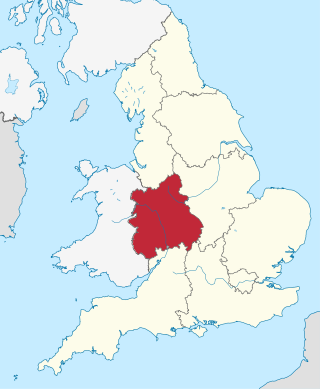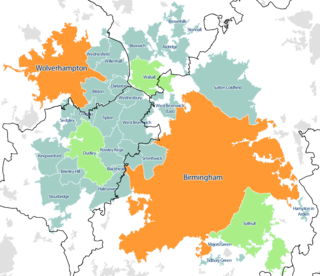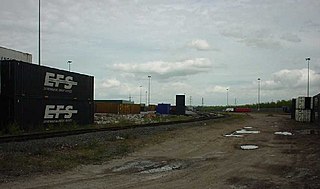
The Midlands are a part of England that broadly correspond to the Kingdom of Mercia of the Early Middle Ages, bordered by Wales, Northern England, Southern England and the North Sea. The Midlands were important in the Industrial Revolution of the 18th and 19th centuries. They are split into the West Midlands and East Midlands. The region's biggest city, Birmingham – often considered the social, cultural, financial and commercial centre of the Midlands, – is the second-largest city and metropolitan area in the United Kingdom.

The A5 is a major road in England and Wales. It runs for about 243 miles (391 km) from London to the Irish Sea at the ferry port of Holyhead. In many parts the route follows that of the Roman Iter II route which later took the Anglo-Saxon name Watling Street.

The West Midlands is one of nine official regions of England at the first level of International Territorial Level for statistical purposes. It covers the western half of the area traditionally known as the Midlands. The region consists of the counties of Herefordshire, Shropshire, Staffordshire, Warwickshire, West Midlands and Worcestershire. The region has seven cities; Birmingham, Coventry, Hereford, Lichfield, Stoke-on-Trent, Wolverhampton and Worcester.

The West Midlands conurbation is the large conurbation that includes the cities of Birmingham and Wolverhampton and the towns of Sutton Coldfield, Dudley, Walsall, West Bromwich, Solihull, Stourbridge and Halesowen in the West Midlands, England. It is also referred to as the Birmingham urban area and is one of the most populated and densely populated built-up areas in the United Kingdom.

Redditch is a town, and local government district, approximately 15 miles (24km) south of Birmingham city centre. Located in north-east Worcestershire, England, The district had a population of 87,036 in 2021. In the 19th century, it became the international centre for the needle and fishing tackle industry. At one point, 90% of the world's needles were manufactured in the town and its neighbourhoods. In the 1960s, it became a model for modern new town planning as the town itself was set as a commuter town for the city of Birmingham.

The Metropolitan Borough of Solihull is a metropolitan borough in West Midlands county, England. It is named after its largest town, Solihull, from which Solihull Metropolitan Borough Council is based. For Eurostat purposes it is a NUTS 3 region and is one of seven boroughs or unitary districts that comprise the "West Midlands" NUTS 2 region. Much of the large residential population in the north of the borough centres on the communities of Castle Bromwich, Kingshurst, Marston Green and Smith's Wood as well as the towns of Chelmsley Wood and Fordbridge. In the south are the towns of Shirley and Solihull, as well as the large villages of Knowle, Dorridge, Meriden and Balsall Common.

Hams Hall is a place near Lea Marston in North Warwickshire, England, named after the former Hams Hall manor house. A power station at Hams Hall was constructed and operated in the late 1920s; a further two power stations began generating electricity in the 1940s and 1950s. By 1993 all three power stations had been closed and demolished and an industrial park Hams Hall Distribution Park was built. An intermodal rail terminal Hams Hall Rail Freight Terminal also operates at the site.

The Birmingham Metropolitan Area is an urban agglomeration located in the West Midlands region of England with a population of around 4.3 million people, making it the second largest metropolitan area in the United Kingdom. It comprises the three cities and four metropolitan boroughs which make up the Metropolitan county of the West Midlands, along with its commuter zones, which extend into the neighbouring district authorities of Bromsgrove and Redditch in Worcestershire; Cannock Chase, Lichfield, South Staffordshire and Tamworth in Staffordshire; and all five district authorities of Warwickshire, including the towns of Bedworth, Coleshill, Nuneaton, Royal Leamington Spa, and Warwick itself.
The West Midlands region straddles the historic borders between the counties of Warwickshire, Staffordshire in the north, and Worcestershire in the south.

Kings Norton railway station serves the Kings Norton and Cotteridge areas of Birmingham, England. It lies on the Cross-City Line from Redditch and Bromsgrove through Birmingham New Street to Lichfield. The station's main entrance is located on Pershore Road South, the A441.

Midland Red was a bus company that operated in The Midlands from 1905 until 1981. It was one of the largest English bus companies, operating over a large area between Gloucester in the south and Derbyshire in the north, and from Northampton to the Welsh border. The company also manufactured buses.

Longbridge railway station serves the Longbridge area in the south-west of Birmingham, England. It is on the Cross City Line. The station and all trains calling there are operated by West Midlands Trains.

Magna Park is a 500 acres (2.0 km2) road warehousing and logistic centre located near Lutterworth, Leicestershire, England. The population of the site is listed in the civil ward of Bitteswell.

Stagecoach Midlands operates most bus routes in Northamptonshire and Warwickshire; the legal name for the company is Midland Red (South) Ltd.The company was previously split into Midland Red in Warwickshire and United Counties Omnibus in Northampton; however, the two were merged together under the Midland Red identity in 2021.
The Greater Birmingham & Solihull Local Enterprise Partnership (GBSLEP) is one of 39 Local Enterprise Partnerships set up by Government to drive economic development in England.
Local transport bodies are partnerships of local authorities in England outside Greater London. There are 38 local transport bodies. They cover similar areas to local enterprise partnerships, but are not permitted to overlap each other. Decision making for major transport infrastructure spending is devolved to these bodies from the Department for Transport. They will receive funding from April 2015.
Structural changes to local government in England have taken place between 2019 and 2021, and will potentially continue in 2023. Some of these changes continue the trend of new unitary authorities being created from other types of local government districts, which was a policy of Communities Secretary Robert Jenrick from 2019. Ceremonial counties will not see any changes to their boundaries, as the Lieutenancies Act 1997 will be amended to reflect the new local government areas that comprise them.
The Felixstowe to Nuneaton railway upgrade in the United Kingdom is a series of upgrades being made to both a key strategic freight route and one that carries passengers on many parts. It is one of only two routes between the busiest container port and the midlands, the other being via London. The route and the upgrade is sometimes abbreviated to F2N. The railway route includes the Birmingham–Peterborough line for a large part. The line links the Port of Felixstowe in Felixstowe, Suffolk, with the Midlands and crosses the East Coast Main Line, the Midland Main Line and the West Coast Main Line and thus the north. From Nuneaton, a number of intermodal terminals maybe reached. Much infrastructure in the UK is of Victorian origin and thus needed an upgrade; F2N, being a key route, is no exception.













